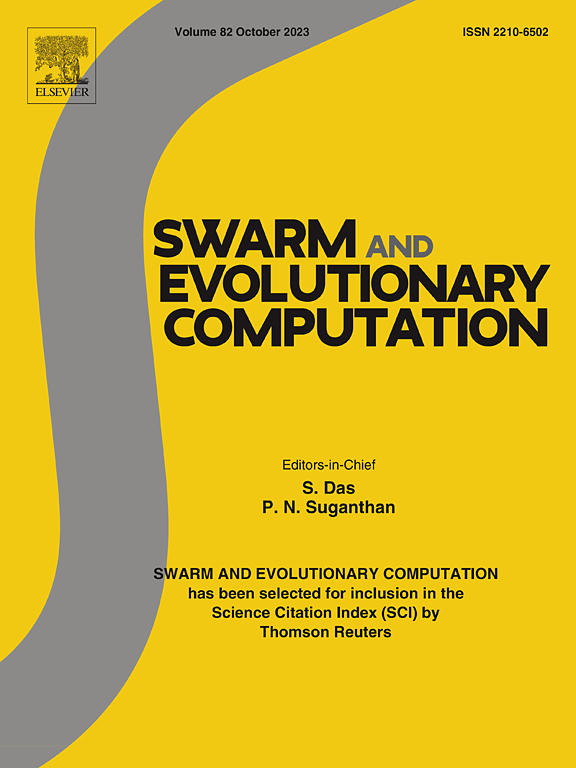A multifactorial evolutionary algorithm to detect stably influential seeds from competitive networks under multiple damage scenarios
IF 8.5
1区 计算机科学
Q1 COMPUTER SCIENCE, ARTIFICIAL INTELLIGENCE
引用次数: 0
Abstract
The complex network has garnered significant attention over the past few decades, with optimization and information extraction problems show significance in practical applications. The competitive influence maximization, along with its robustness, has emerged as a recent focal point, which is aimed at identifying seeds with robust and influential capabilities across multiple propagative groups within a specific network. Existing studies indicate the damage percentage of link-based failures can be pre-defined, and solving the problem in a single-objective manner. However, it has been demonstrated that multiple damage scenarios are prevalent, and the corresponding search processes may yield the synergy. Therefore, the correlation between the optimization directed at different damage scenarios of link-based attacks is analyzed first, which has shown non-conflict relation. Consequently, the multitasking optimization paradigm is thus introduced to modeling the related robust influence maximization problem. A numerical metric is also designed to reflect the significance of links on competitive networks. Equipped with this metric, a multifactorial evolutionary algorithm has been developed to tackle the seed determination problem under multiple damage scenarios, termed MFEA-RCIMMD. The involved operators consider diverse information from both genetic and fitness domains, and a multi-phase transfer operation is included to leverage knowledge across different tasks. Experiments on synthetic and real-world networks demonstrate the remarkable performance of the algorithm over existing single-objective and multitasking approaches. With enhanced efficiency, multiple candidates are provided for decision-makers to address diffusive challenges in practical systems.
基于多因素进化算法的竞争网络中稳定影响种子的检测
在过去的几十年中,复杂网络受到了广泛的关注,其中优化和信息提取问题在实际应用中具有重要意义。竞争影响力最大化及其稳健性已成为最近的一个焦点,其目的是在特定网络内的多个传播群体中识别具有稳健性和影响力能力的种子。现有研究表明,基于链路的故障的损坏百分比可以预先定义,并以单目标的方式解决问题。然而,已有研究表明,多种损伤场景是普遍存在的,相应的搜索过程可能产生协同效应。因此,首先分析针对基于链路攻击的不同破坏场景的优化之间的相关性,显示出不冲突的关系。因此,引入多任务优化范式来建模相关的鲁棒影响最大化问题。还设计了一个数字度量来反映竞争网络中联系的重要性。在此基础上,提出了一种多因子进化算法MFEA-RCIMMD,用于解决多种损伤情况下的种子确定问题。所涉及的算子考虑了来自遗传和适应度领域的不同信息,并包含了一个多阶段的转移操作,以利用不同任务之间的知识。在合成网络和实际网络上的实验表明,该算法比现有的单目标和多任务方法具有显著的性能。随着效率的提高,为决策者提供了多个候选人来解决实际系统中的扩散挑战。
本文章由计算机程序翻译,如有差异,请以英文原文为准。
求助全文
约1分钟内获得全文
求助全文
来源期刊

Swarm and Evolutionary Computation
COMPUTER SCIENCE, ARTIFICIAL INTELLIGENCEC-COMPUTER SCIENCE, THEORY & METHODS
CiteScore
16.00
自引率
12.00%
发文量
169
期刊介绍:
Swarm and Evolutionary Computation is a pioneering peer-reviewed journal focused on the latest research and advancements in nature-inspired intelligent computation using swarm and evolutionary algorithms. It covers theoretical, experimental, and practical aspects of these paradigms and their hybrids, promoting interdisciplinary research. The journal prioritizes the publication of high-quality, original articles that push the boundaries of evolutionary computation and swarm intelligence. Additionally, it welcomes survey papers on current topics and novel applications. Topics of interest include but are not limited to: Genetic Algorithms, and Genetic Programming, Evolution Strategies, and Evolutionary Programming, Differential Evolution, Artificial Immune Systems, Particle Swarms, Ant Colony, Bacterial Foraging, Artificial Bees, Fireflies Algorithm, Harmony Search, Artificial Life, Digital Organisms, Estimation of Distribution Algorithms, Stochastic Diffusion Search, Quantum Computing, Nano Computing, Membrane Computing, Human-centric Computing, Hybridization of Algorithms, Memetic Computing, Autonomic Computing, Self-organizing systems, Combinatorial, Discrete, Binary, Constrained, Multi-objective, Multi-modal, Dynamic, and Large-scale Optimization.
 求助内容:
求助内容: 应助结果提醒方式:
应助结果提醒方式:


